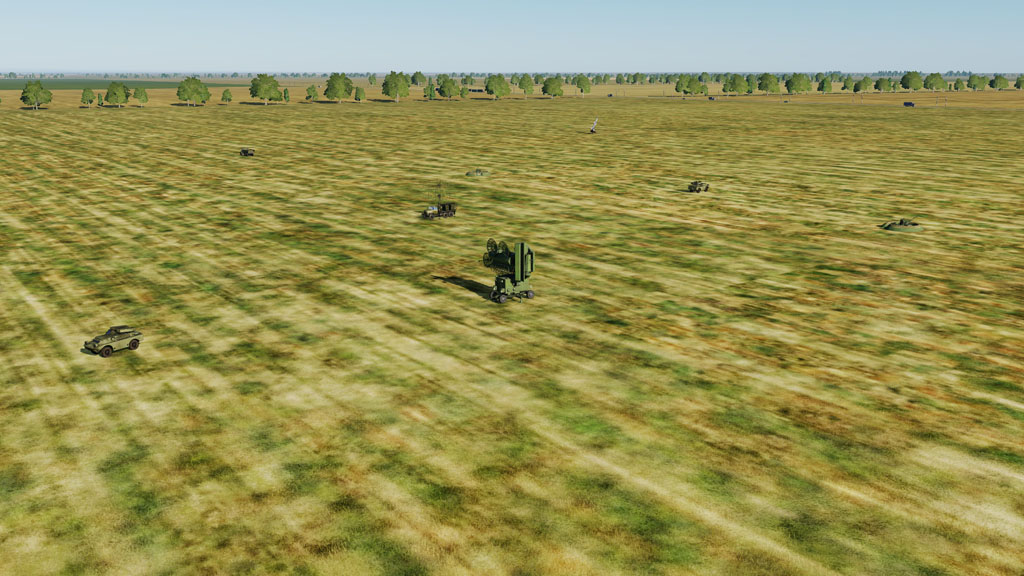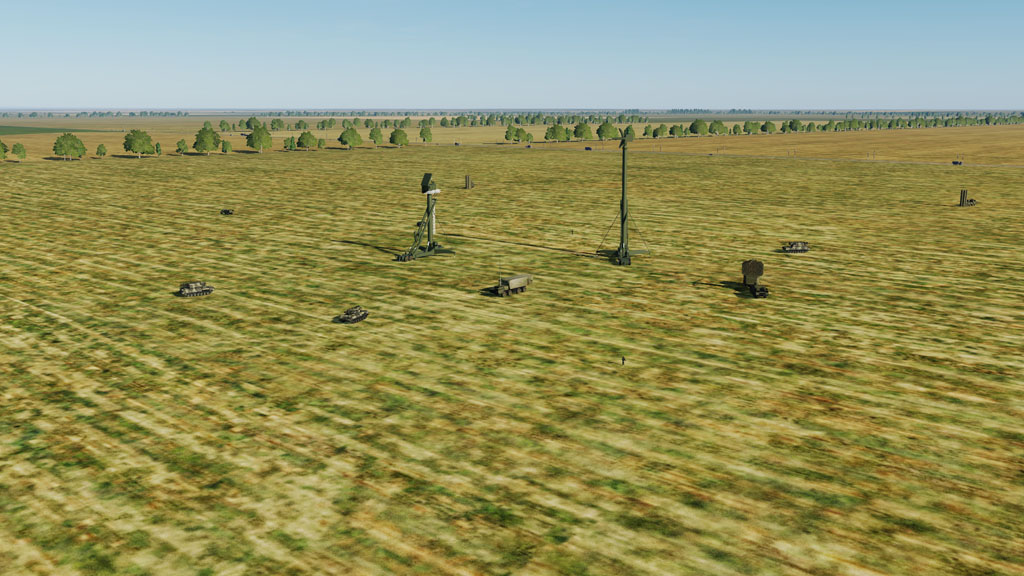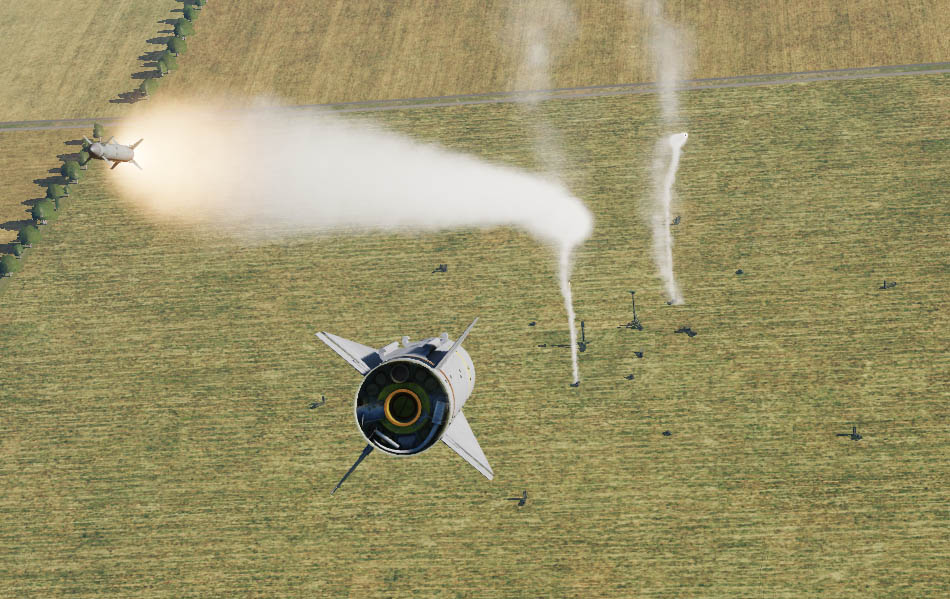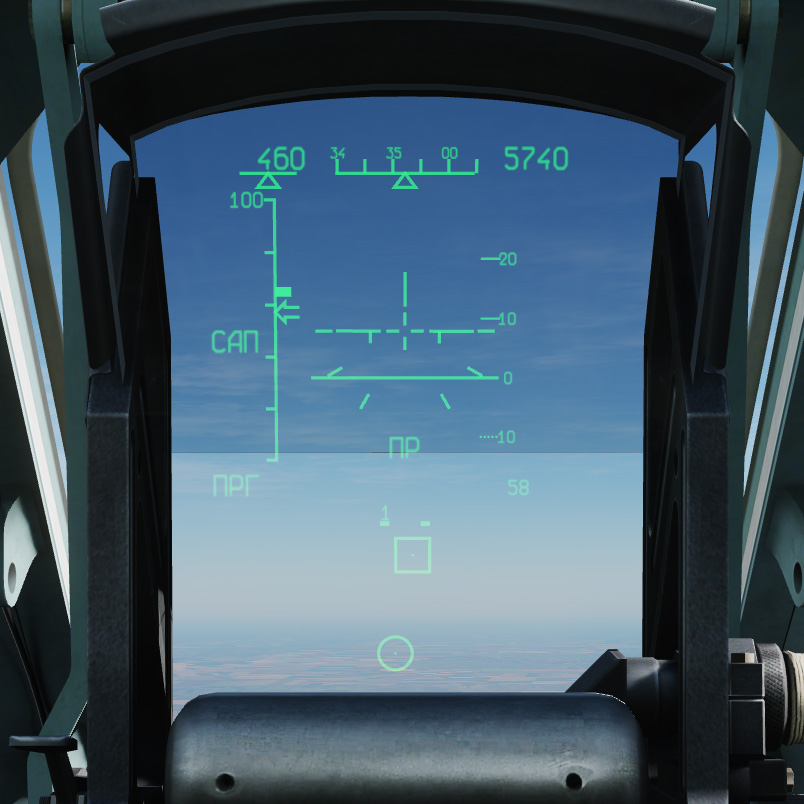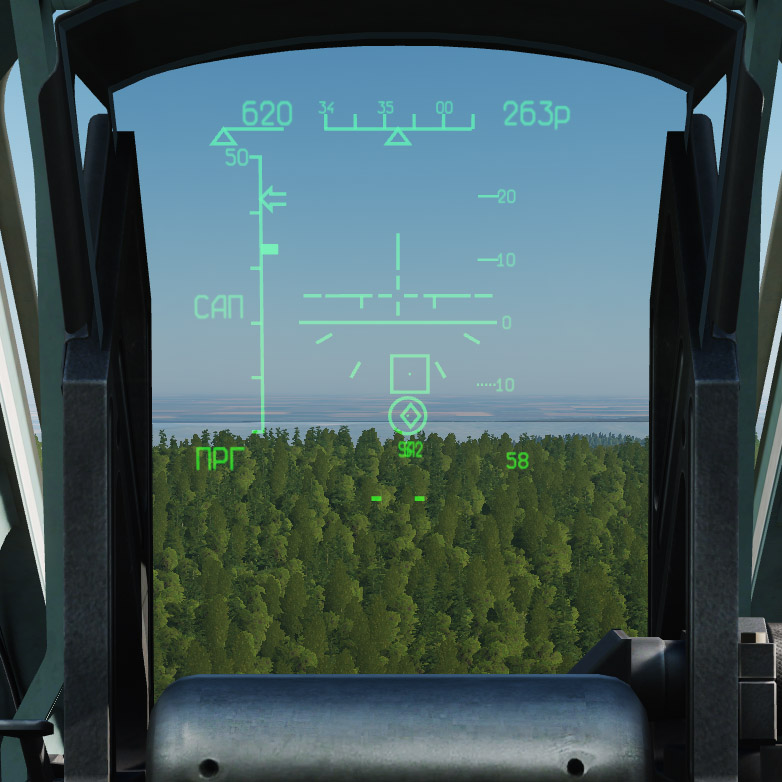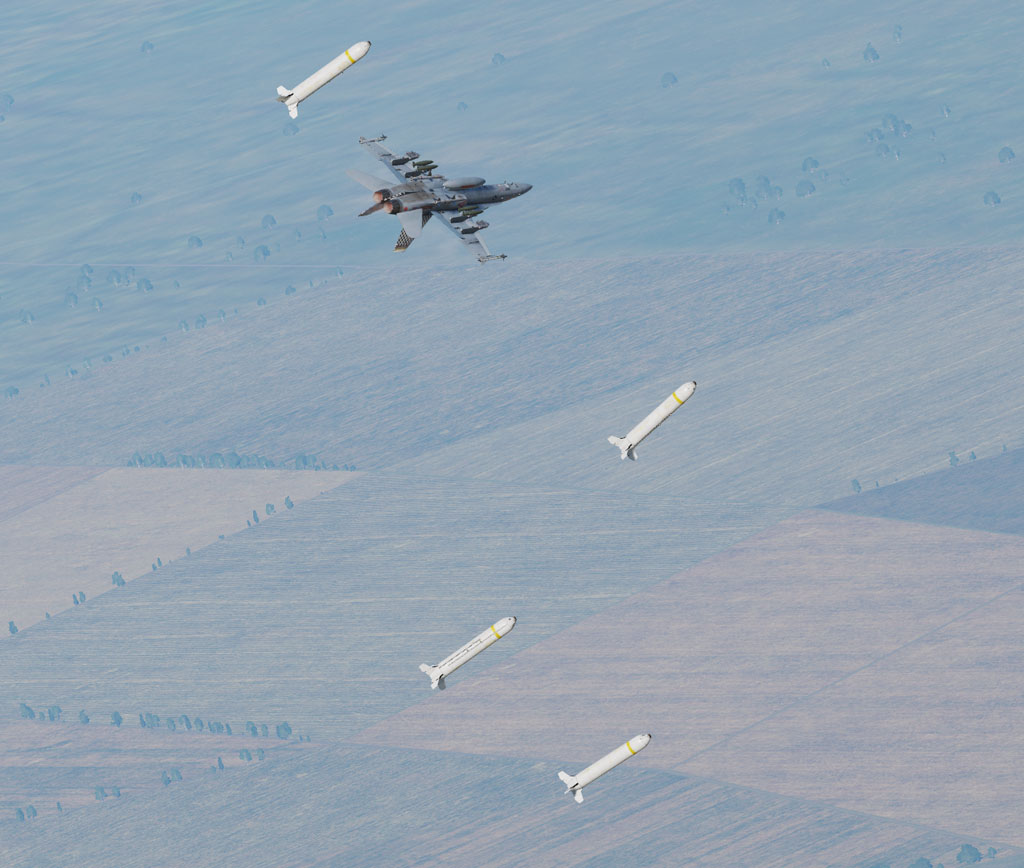SEAD and DEAD: a DCS primer
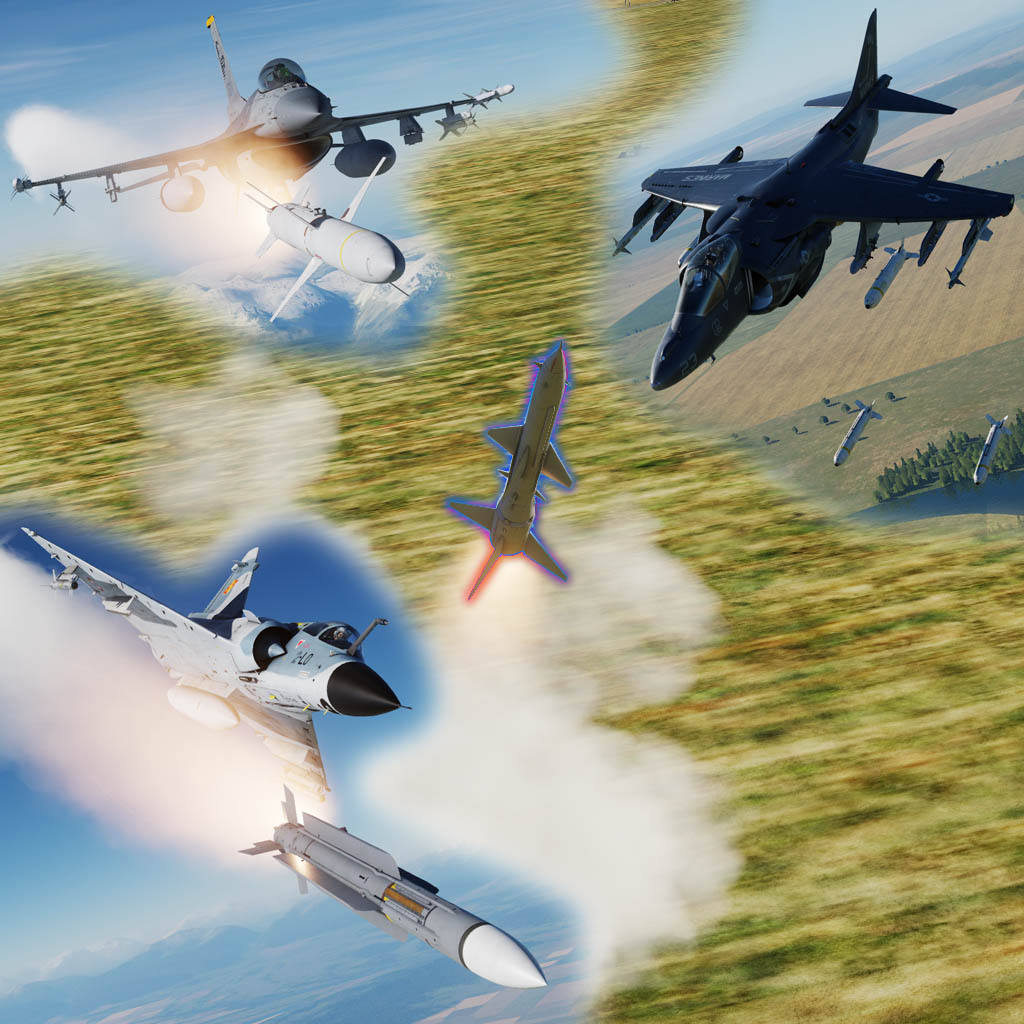
SEAD and DEAD defined
SEAD and DEAD are two separate yet related concepts: SEAD means Suppression of Enemy Air Defenses, while DEAD means Destruction of Enemy Air Defenses. In the case of the first, the goal is not destruction of air defenses, but nullification of their capabilities – aka, suppression. For DEAD, the goal is actual destruction of air defenses. Despite what one may think, one does not lead to the other, although they can be used in tandem.
Why does it matter?
SEAD generally has a very different end state than DEAD: air defenses may be too difficult or well defended to attack directly, with factors such as terrain, intelligence, low altitude defenses, and hostile aircraft impacting whether or not an air defense system can be effectively attacked. Weapons such as the AGM-45 Shrike, AGM-78 Standard ARM, and AGM-88 HARM have only the ability to track radiation sources and only if the emitter remains on for the duration of the weapon’s flight. This means that an air defense system may shut off their radars at any point and result in a wasted missile (some more modern weapons have alternative guidance mechanisms; this will be discussed later). The end result is that the air defenses are likely still in place and an effective threat. Alternatively, the air defense system may only lose one of its radar systems, which can easily be replaced or repaired, and it may not be a critical radar to the site’s operation.
DEAD, by contrast to SEAD, effectively destroys the air defense in question: launchers, nearby support equipment, munitions stockpiles, and so on are destroyed or rendered unusable. This goal is much harder to achieve as it requires planning, coordination, and a greater pool of resources than SEAD. SEAD may only require a handful of aircraft, while DEAD requires coordination of several flights of differing aircraft and capabilities. Depending on the era, it also incurs a much greater amount of risk to attacking aircraft.
Can there be a distinction within DCS?
DCS, at the time this article was written, does not have a robust framework for air defense systems or networks. The concept is referred to as IADS, or Integrated Air Defense System, as it involves a defensive plan starting from the ground up. An IADS incorporates low altitude systems like MANPADS, AAA, SA-9, SA-13; medium altitude systems such as Roland, SA-15, SA-19; high altitude/theater defense systems like the SA-10 and Patriot; early warning radar systems; and fighter aircraft. This combination of systems results in a virtually-impenetrable airspace, with few access points. This network is also typically set up with overlapping spheres of defense, so redundancy is built in, further enhanced by data links between systems.
With the addition of scripting mechanics, a mission can have an IADS and simulate some of the vulnerabilities as well as the difficulties of penetrating a robust (or otherwise) network. This then makes the distinction between SEAD and DEAD much more clear, provided the scenario is designed to support it.
Out of the box, the difference is less noticeable: anti-radiation missiles will effectively disable a SAM system if launched within parameters, as air defenses will never shut off their radars in anticipation of attack – or in any other event. This blurs the lines such that the main variance between the two becomes weapons and strategies used versus end state. In addition, there’s no way for a SAM site to repair or replace any destroyed radars. This can be offset with some systems such as the SA-11, which have independent track radars on each launcher, meaning that the actual search radar is only part of the picture. A scenario designer may also have multiple radars attached to a site for redundancy.
As the electronic warfare model is grossly simplified and only accounts for self protection jamming, not offensive jamming, out of the box DCS can only partially simulate the various tactics and procedures utilized in attacking or suppressing air defenses.
SAM site composition
By default, DCS SAM templates do not incorporate many, if any at all, defenses for the site itself. This makes the site a relatively easy target: even the most advanced SA-10 and Patriot systems have minimum range and altitude limits, which leaves them vulnerable to something as simple as a close range helicopter attack. Most scenarios account for this and have a few short range defenses set up; others have entire dedicated groups of lethal equipment to defend it.
For the purposes of this article, a semi-realistic assumption is made that a site will have equivalent defenses for the generation it yields from. Any site will likely have a number of MANPADS by default, which can add a nasty sting to those unaware, plus AAA systems of varying capacities. SA-10s can incorporate additional SA-15 and/or SA-19; SA-6 and SA-11 can incorporate SA-8, SA-9, and SA-13; older generation systems like the SA-2 should also have SA-3 and SA-9. Western systems are often left with few options outside of Avenger and Stinger, with some alternatives with the Roland and Gepard. These low to medium altitude ADA systems nullify the ability for aircraft to close in and destroy the larger theater SAM from its minimum engagement envelope.
Many of these lower altitude systems have anti-missile capabilities, so in event that some weaponry passes through the larger SAM’s envelope, they will add their own weapons to the mix. In addition, slower weapons like the AGM-154 and Bk.90 are easily targeted by AAA. Only munitions operating at high speed (read: those launched closer) can easily pass through this defensive network. The most outdated equipment lacks these capabilities.
SEAD
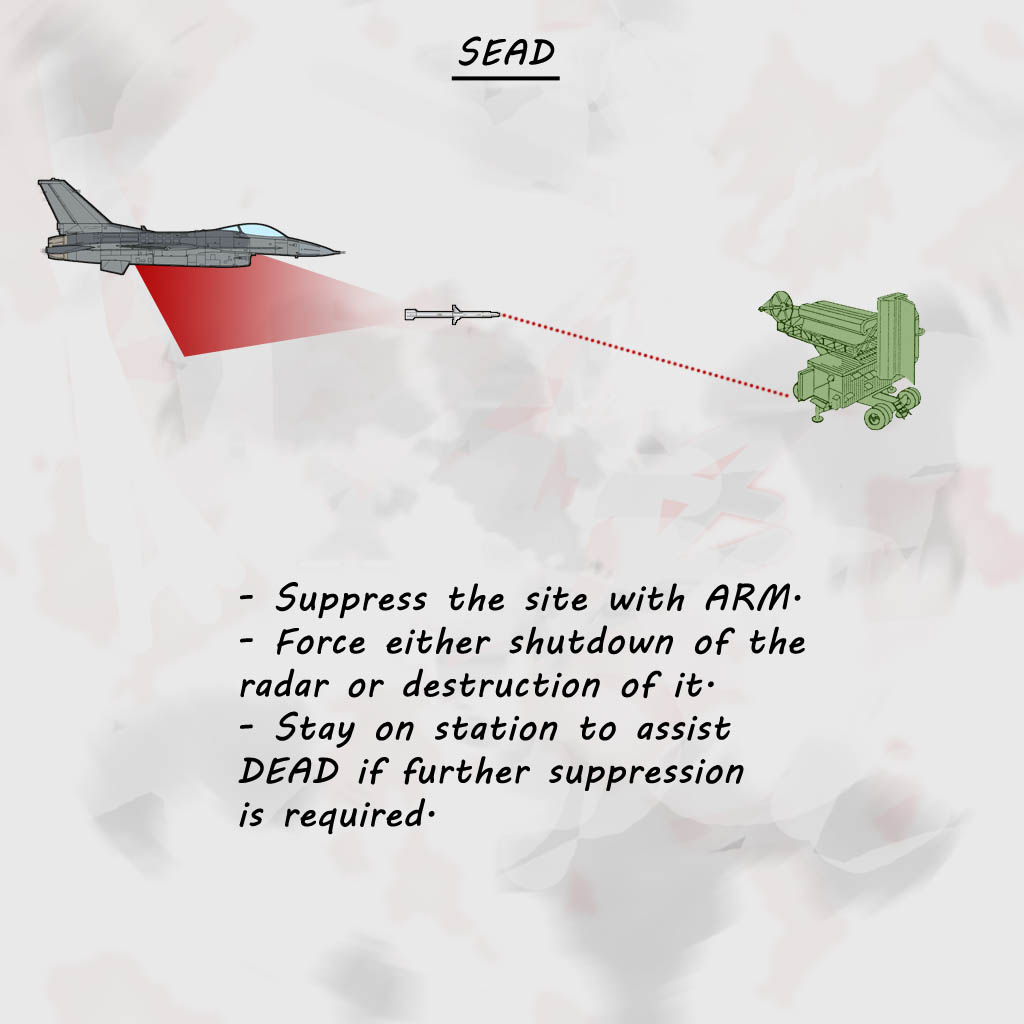
Now that we’ve established what SEAD is and the end goal, how can we perform it? The available platforms are the F-16C Block 50, F/A-18C Lot 20, AV-8B NA, JF-17, and Su-25T. All of these aircraft have the ability to carry and launch anti-radiation missiles. Both the F-16 and the F/A-18 utilize the AGM-88C, the variant of which is nondescript (most likely a C-1 Block V, which was in service around 2000); the AV-8B can equip the short-ranged AGM-122; the JF-17 has the powerful LD-10; and the Su-25T has the option of the Kh-58, Kh-25MP, and Kh-25MPU. All of these weapons have their own advantages and disadvantages from their respective platforms.
With the goal of suppression in mind, the first step should be to coordinate what threats need to be suppressed and for how long. It will do no good to waste fuel and ordnance suppressing a threat with no one around to exploit that suppression. Once a threat is identified for suppression, the next step is to account for capabilities. Older systems like the SA-2 have many limitations that can be exploited, while modern systems like the SA-10 are incredibly hard targets. The system capabilities will determine how you can suppress it and what tactics can be used to defend against it.
Plainly speaking, striving to get the most altitude, the most speed, at the closest range will always result in the best performance of any munition. A weapon launched with a huge starting speed and altitude advantage will retain more energy and represent a much harder return target for any defending systems. However, this also means the launching aircraft is placing itself in much greater danger for return fire. In addition, these missiles often have seeker limits that may preclude certain launch conditions. For example, the AGM-88 can boast an incredible range – but only in very specific modes and from very specific launch conditions. In absence of those conditions, the operational limits are closer to ~35nmi.
As the goal is suppression, not destruction, close coordination with other assets is the key to success. Any other aircraft waiting for suppression must be available to quickly take advantage of any openings to conduct their tasks. It becomes critical that those tasked with SEAD are timed and positioned with flights tasked with operating while air defenses are suppressed. This is why Time On Target is a vital part of real-world planning, as windows are often only open for a short period of time.
For suppression to work, it is important that the inevitably limited pool of missiles not be expended all at once. As flight sizes are typically quite small in DCS, it is better to expend one missile and wait for it to hit or distract the target prior to expending another one. It is also preferable for the SEAD aircraft to distract the SAM with their own aircraft. While dangerous, this can be leveraged in many situations to force the SAM to expend limited munitions on an aircraft focused on defeating those munitions, which may not be possible for other flights in the package.
Without weapons such as the HARM, it is also possible to suppress a SAM by decoys. Currently, only the F-14 can deploy the ADM-141 TALD, though it is slated to arrive at some point for the F/A-18. These decoys can be utilized to distract the SAM and force it to waste valuable missiles. In a pinch, other weapons such as the AGM-84 and AGM-154 can be utilized to decoy a SAM site, although doing so might be considered wasteful. Some of the more capable systems will also attempt to shoot down anti-radiation missiles, making these weapons useful decoys as well. On average, SAM systems in DCS will employ two missiles per valid targets. As a typical site contains an average of 4 launchers with 4 missiles each, this means at least 16 missiles must be evaded or decoyed in this manner.
Another important consideration is that SAM logic is simple: they will attack the target closest to their launch parameters, which can vary depending on speed, altitude, and whether or not they can see it. An aircraft directly overhead may not be seen as the best target to attack, while an aircraft further out on the edge of the engagement zone might seem more inviting. The aircraft at the highest altitude and highest closure speed relative to the SAM is most likely to be attacked; this unfortunately is also one of the hardest aspects to defend from. As most aircraft have difficulty maneuvering at high speed and altitude, it may take too much time to shift to an evasion, allowing a missile to get within lethal radius regardless of defensive actions. It goes without saying that a successful defense involves diving into denser air, which can potentially put the aircraft into range of lower altitude systems.
DEAD
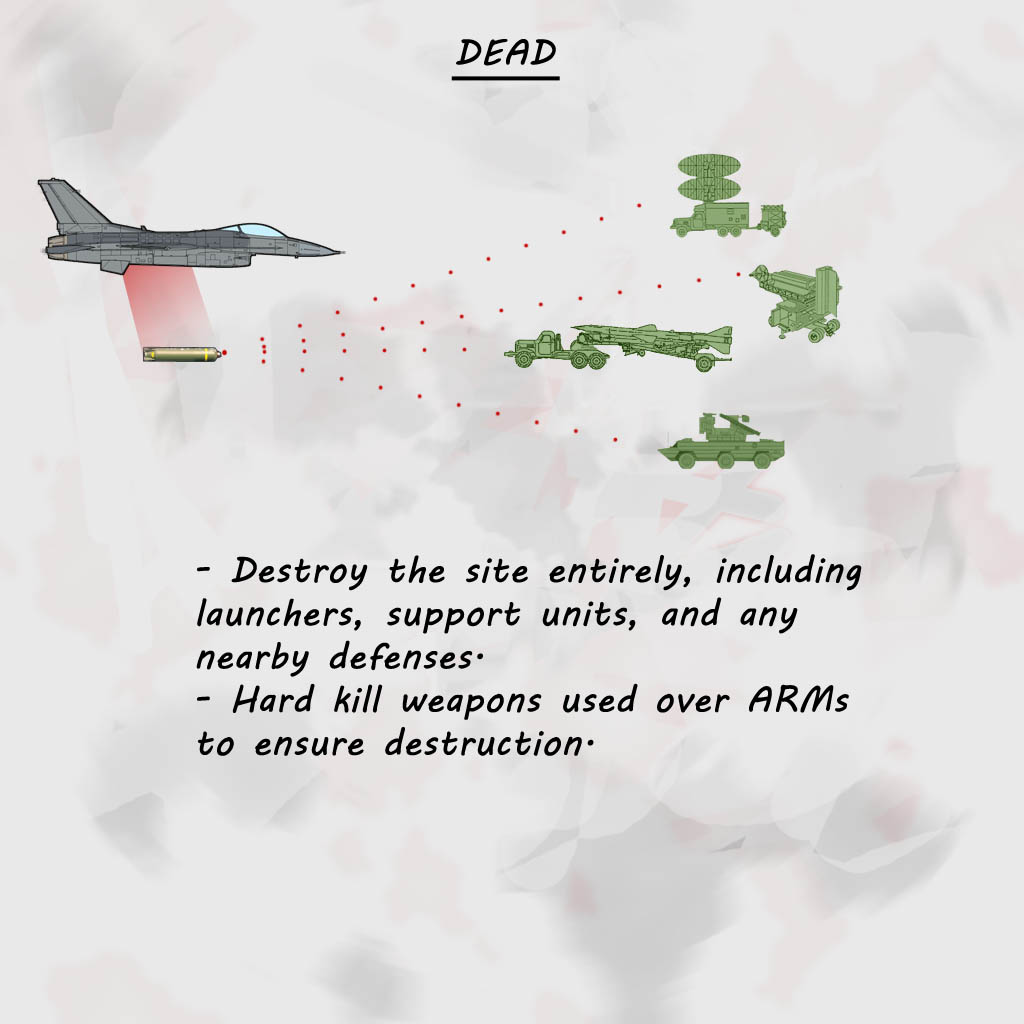
Within DCS, DEAD is more straightforward, though many times more challenging than SEAD. While anti-radiation missiles can be used to assist in the goal of DEAD, destruction is best served by hard kill weapons such as the CBU-97 and AGM-65. Depending on site defenses, this can either be extraordinarily easy or almost impossible; site location, terrain, close in defenses, and other factors will determine relevant strategies for destruction.
One of the most effective techniques is toss bombing, which favors faster aircraft like the F-16. If the position of the site can be extrapolated, then that position can simply be entered in as a waypoint for CCRP cues. The site can then be attacked from a distance of 3-5nmi, depending on weapon used and speed. A small warning: certain cluster bombs cannot have their burst height altered, which considerably increases the risk to releasing aircraft. CBU-99/Mk20 bombs are hard coded with a 1200ft burst height, while CBU-87/97 are fixed at 1500ft for the F-16 at present time (the A-10C can adjust the burst altitude on these weapons). Nominally, iron bombs offer the most range for the safest release altitude, but pay the price with more limited destructive abilities. If available, JDAMs can also be tossed, which offer a precision engagement capability to this form of attack.
Missiles like the AGM-65 offer increased standoff distance and more options, but are very vulnerable to anti-missile systems like the SA-15 and SA-19. As noted in the previous section, anti-radiation missiles can be used, but are limited to targeting radars alone – which may be problematic if there are no radars to home in on! The other factor with many missiles is that their ability to lock on can be heavily inhibited by launch conditions; the same as ARMs have better performance when launched from higher and faster, other types of missiles also benefit. In absence of those parameters, missiles may end up offering only slightly greater range than a tossed bomb. In particular, the AGM-65 seekers – both TV and IIR – require the launch platform to stay relatively stable and get fairly close before a lock is achieved. Laser guided missiles will also require a constant laser spot source, which may not be guaranteed against a more lethal SAM system.
If coordinating between SEAD and CAP, then bombing from high altitude can be a viable solution. Utilizing JDAM, LGBs, or other guided bombs, attacking aircraft can fly over the envelope from low-medium defenses and engage the site at will. An open suppression window by the SEAD aircraft will enable DEAD aircraft to move in and engage in this envelope, which exists from approximately 25,000 feet and above. This is the rough maximum altitude that systems like the SA-15 and Roland can engage at. It goes without saying that target prioritization should be any tracking radars, followed by search, and finally low-medium defenses.
What’s that? Why would we attack the defenses before engaging other parts of the site? Because without the radars, the site is effectively useless; it is imperative to bring down the most threatening parts of the site in order to enable a more effective attack. That means that SA-15, SA-19, Roland, etc. become the priority, as these systems can be effective at aerial denial in their own right. Elimination of these targets can bring down the minimum altitude from 25,000 feet to 12,000 feet, which allows much greater (and quicker) elimination of the site. As noted, some systems have independent tracking radars for the launchers, but these still have minimum altitude and range limitations that defensive ADA may not have.
Weapons
For the purposes of this article, SEAD weapons are broadly categorized as ARMs. Any missile that homes in on an emitting radiation source cannot be relied upon for hard kill purposes; many of them are designed to fragment and destroy radar dishes and associated sensors, not the vehicle or structure it may be mounted on. Further, if the radar is turned off, the weapon may never be able to hit the target at all – only a handful of modern ARMs not simulated within DCS are capable of hitting an emitter’s position without the radiation source being left on. In addition, there are various ways to deceive an ARM, such as the ubiquitous microwave oven. With all the electronic noise to contend with, an ARM’s accuracy is severely degraded without a strong signal to home in on.
Most of these are not concerns within the framework of DCS, unless the mission designer incorporates it in some way (such as lots of benign search radars). However, radar shutoff is a relatively simple mechanic to incorporate, and can spoil most ARM shots if the timing is right. Other mechanics include sites remaining offline until threats are within a no escape range, utilizing other detection sources such as early warning radars to locate aircraft. These features can make a mission exponentially more complicated, so they are not seen often. As a result, most ARMs are de facto destructive shots for anything but the most armored or protected sites. Nonetheless, utilizing other weapons can be more effective than ARMs for a variety of reasons.
Missiles are simultaneously the best and worst weapons for neutralizing an ADA system: they allow attacking aircraft a standoff range outside of defenses and in many cases are fire and forget; however, this is tempered by the ability of some defenses to shoot them down. Most missile’s launch parameters leave them incredibly slow in their terminal phase, which makes them vulnerable to anti-missile defenses such as the SA-15. In addition, their approach angle is often in the low horizontal, an easy aspect for most defenses to acquire and track. Some of this can be mitigated by launching from closer ranges, but this obviously puts the launch platform in much greater danger.
Bombs are the preferred hard kill weapon for SAM sites: they’re hard to intercept, can be employed from high altitudes, and can easily destroy hardened targets. Cluster bombs are probably the most effective in this class, as their ability to spread submunitions over a large area can disable an entire site. The CBU-97 and 105 are the absolute best for this purpose, given how their submunitions are extremely accurate and deadly. Due to current DCS limitations, other cluster bombs won’t have the same devastating effect as the CBU-97/105 (in particular the CBU-87/103), but are still viable weapons for hitting large portions of a site. Guided bombs are also highly useful, as they allow using altitude cover to precisely target parts of the site without entering the effective range of low altitude defenses.
Within the context of ARMs, only two weapons provide relatively accurate capabilities if an emission source is lost: the LD-10 and AGM-88. In the case of the LD-10, using the active mode will pass coordinates to the weapon for an approximate position of an emitter, allowing the missile’s INS to potentially get close enough to hit without an active radiation source. Neither the self protect or passive modes are precise enough to hit without an emitter. For the AGM-88, the position range unknown mode available to the F-16C allows a fairly precise hit, provided the position coordinates are accurate enough. Presumably, future pre-briefed modes will allow for an accurate enough hit, depending on conditions. Self protect, HARM as a sensor, and target of opportunity modes are not accurate. No other ARMs available have position-targeting modes as the two previously mentioned weapons.
Basic strategies: SEAD
It goes without saying that the basics noted before apply here: the fastest speed, from the highest altitude, for the longest range. Unfortunately, this can all be used against the launching aircraft. To get around this, we can mask our presence in a variety of ways until we are ready to suppress the target.
Each platform capable of launching ARMs has their own mechanisms to employ those weapons, with advantages and disadvantages for each way, while some are universal. The Su-25T is simple: using the Fantasmagoria pod to see the available radiation sources, lock the desired threat up, and fire when in range. This is functionally identical to the F-16’s HAS mode and the F-18’s TOO mode. The JF-17 lacks an equivalent, but the closest is the passive mode, which tracks the strongest source from the launch axis. These modes all allow for an immediate launch if so desired (the Su-25T’s launch override function will have to be used), which is ideal for suppression.
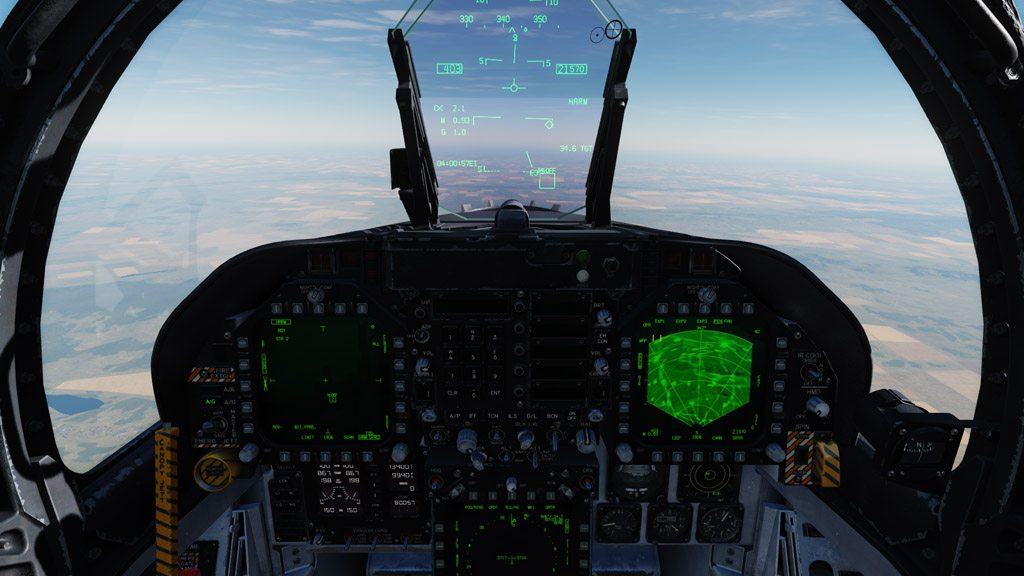
The goal in this case is to “threaten” the target into shutting down its sensors; they may not know that the weapon is capable of hitting them, merely that a weapon has been launched at them. As this is highly scenario dependent, it’s no guarantee that the missile will have the desired effect, but it is an important trick to remember in a pinch. With enough speed and altitude, a weapon just might have enough energy to strike the target from a range longer than otherwise indicated. Alternatively, a missile launched that has virtually no chance of hitting is still a missile launched, which may be just enough to cause the target to do something – systems like the SA-10 do not have enough logic to know if a missile will hit or not and will use their own ordnance in an attempt to hit the weapon.
For most target systems, it’s very much possible to get within a good launch range before (or right on the edge of) their own launch envelope. This is especially true if the system is a more tactical system such as the SA-6. One can safely come in high and fast with little danger, suppressing the site for later destruction. This does not apply for larger systems such as the SA-10 or Patriot: these have more than enough range and defensive capabilities to deny effective launch parameters for most ARMs. There is then a simple solution to close the distance: get low!
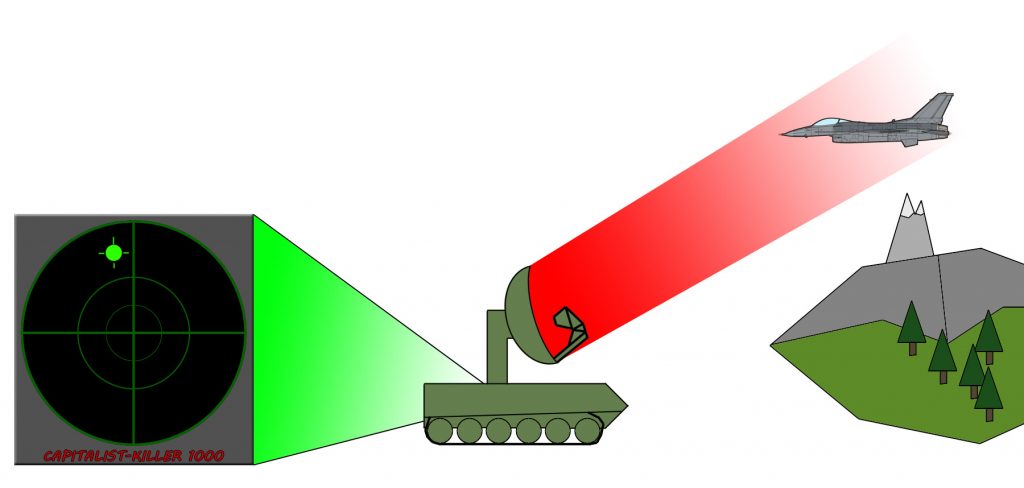
For much of the Cold War, western/NATO strategies were built around the idea that staying low was the most effective way for air power to penetrate the Warsaw Pact/Soviet Union ADA umbrella. This was a viable strategy since terrain features, system capabilities, and aircraft employed by the Warsaw Pact were not incredibly effective at low altitude engagements. As an example, the SA-6’s radar, the SURN 1S91 (NATO “Straight Flush”) could only track targets flying above 300 feet (do note that later versions lowered this limit considerably). Aircraft radar sets were equally poor at look-down situations, and even IR missiles had great difficulty tracking through the various ground clutter. Short ranged defenses were limited to tail on IR missiles, AAA, and limited capability short-ranged low altitude systems like the SA-8. This made low altitude ingress and egress the order of the day. While late Cold War systems overcame many of these limitations, the problem remains: anything that flies low is flying in an environment that is nominally filtered out by most sensor systems.

Using low altitude as an advantage, it is possible to get close enough to a target, bob up, and employ an ARM within an effective range while staying outside the lethal radius of defensive systems. Certain modes like the F-16’s POS RUK mode are incredibly useful for this, as they lock on after launch and don’t require an active emitter to fire. This is not without hazards, however: flying low can easily put the launching aircraft at the mercy of enemy aircraft. Close coordination with CAP and DEAD therefore is still incredibly important.

Another possible strategy involves decoying the site: TALD, which can currently be equipped on the F-14 (and the F-18 in the future), will fly a linear course from release, appearing as a radar contact to the site. This can result in the system focusing on a decoy, allowing SEAD aircraft to close the distance and launch suppressive weapons. As an alternative, weapons such as the AGM-84 will also appear as a viable target to most systems and can be used as a decoy or even attack measure. Finally, aircraft themselves can be decoys – just like the original Wild Weasels.
Basic strategies: DEAD
There’s no shortage of ways to perform DEAD: if the site is suppressed, then it can easily be targeted by flying at altitude and picking off targets at will with guided bombs; missiles can be utilized to engage it from outside the range of defenses; bombs can be tossed; high speed, low altitude attacks with a variety of weapons can be used. The mechanism used will vary depending on the risk and platforms available.

The most straightforward DEAD strategy is simple: utilizing guided bombs, fly at an altitude higher than the defenses can shoot and engage the site at will. Only a handful of low to medium altitude systems can engage above 25,000ft, allowing a comfortable margin to pick off the site from relative safety (provided the main ADA system is suppressed). Beware: if a site is placed on a high point of ground, the maximum altitude for many systems increases. If the ground level is 5,000ft, then your safe altitude is now above 30,000ft! It is important to keep this in mind, as your hard deck will need to change based on conditions and threats. Note that this method of attack can also apply to CCRP unguided bomb drops, but it is best to do so with cluster bombs to increase hit probability.
Another highly useful bombing strategy is toss bombing: from low altitude, accelerate to maximum speed, then make a pull up maneuver roughly 5nmi from the target, coming into a shallow climb. Utilizing the CCRP mode available on most aircraft, you can quickly send your bombs into the target area while minimizing your exposure to threats. The only problem with this method of attack is the accuracy is comparatively limited, which means many attacks must be performed or cluster bombs must be used. It can also be performed with guided bombs, but one must have a thorough map of the site prior to execution. This method of attack tends to require an aircraft capable of high speed; it’s rather awkward to attempt a toss bomb with an A-10.
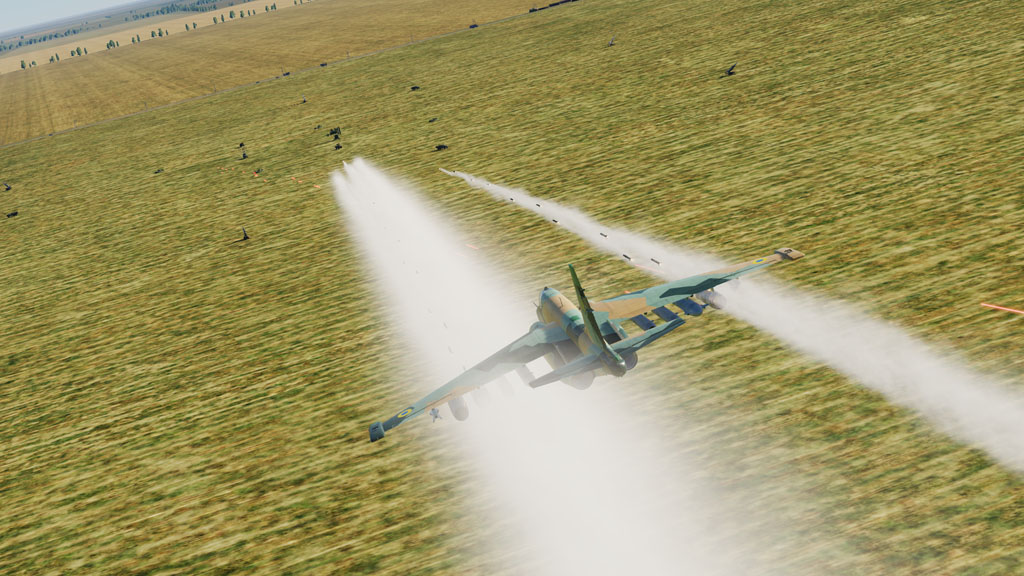
If you’re left in the awkward position of lacking advanced CCRP options or advanced guided bombs, all is not lost: by sticking to the principles detailed above – low and fast – then conditions may allow for quick attacks with cannon, rockets, or dumb bombs. Do not expect to loiter with this attack, however; you will have one opportunity to surprise your target, after which they’ll be waiting for you. Release everything you’ve got in one pass, then get out!
Conclusions
This is not intended to be a comprehensive guide for all things SEAD and DEAD. As noted at the start, a true IADS is a moving target, with many interlinked pieces that can make it an incredibly difficult foe. Much depends on how far the scenario designer is willing to go with regards to incorporating an IADS; it goes without saying that placing such a system within a mission is no small feat. For those going the extra mile, it can add a challenging but rewarding mechanism to a mission, enhancing player experience greatly. However, even without a robust IADS system, ADA within DCS can still present many challenges that may take many different approaches to defeat. There is no one size fits all approach when dealing with ADA: terrain, environment, capabilities, and other factors will dictate what you can and can’t do.
Key takeaways:
- ARMs are not hard kill weapons.
- ARMs cannot be relied upon to disable an ADA site in its entirety.
- Not all hard kill weapons are equal.
- Know what your target is composed of, its capabilities, and its defenses.
- Low altitude is one of the safest places to be, but beware of enemy fighters and low altitude defenses.
Missions
As part of this article, this mission pack sets up four simple SEAD-DEAD scenarios against varying threats. They can be played alone or as part of a group.
Resources
What is a Modern Integrated Air Defense System (Maj. Peter W. Mattes, Air Force Magazine)
Flexible, Smart, and Lethal (2LT Elliot M. Bucki, Air & Space Power Journal)
Planting the seeds of SEAD (MAJ William A. Hewitt, Air University)
Countering Air and Missile Threats (Joint Chiefs of Staff)
